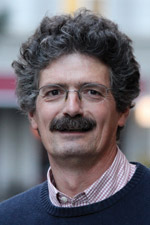 Pittsburgh Theological Seminary will host Dr. Christoph Uehlinger from the University of Zürich, Tues., Nov. 19, 2013 at 7:30 p.m. for the archaeology lecture “Kuntillet 'Ajrud Yahweh, ‘His Asherah,’ and Much More.”
Pittsburgh Theological Seminary will host Dr. Christoph Uehlinger from the University of Zürich, Tues., Nov. 19, 2013 at 7:30 p.m. for the archaeology lecture “Kuntillet 'Ajrud Yahweh, ‘His Asherah,’ and Much More.”
When archaeologists excavated the site of Kuntillet 'Ajrud (Horvat Teman), situated on the Judah-Sinai border, they discovered an early eighth-century BCE caravanserai that yielded, according to most interpretations, a number of religious artistic and epigraphic works. The recent publication of the team’s final report allows for a thorough reevaluation of this hitherto unique place, which has stood at the heart of scholarly debates on the religion of ancient Israel during the Iron Age II period.
Included among assorted processional scenes, animal depictions, and stylized palm trees, the purported artistic presentation of Yhwh with a female companion at His side (an interpretation of a scene depicted on some large jars found at the site) immediately sparked some of the most perplexing questions ever addressed by archaeological and biblical scholars. Did the ancients really believe that Yhwh had a consort? If so, was she Asherah, the great mother-goddess known from Canaanite texts? And whoever the couple represents in the scenes from 'Ajrud, why did the inscriptional materials affiliate them with Samaria, the capital of the northern kingdom of Israel, and not Jerusalem?
While these questions quickly assumed a position at the core of the debate on how best to understand the provocative discoveries at Kuntillet 'Ajrud, many other issues deserve equal attention in a study of both the site in its particular environment and the archaeological evidence as a whole. This lecture by Professor Christoph Uehlinger, an expert on ancient iconography, will scrutinize what we can and cannot know from Kuntillet 'Ajrud based on the excavator’s new report. As a counterpoise to various sensational claims, the illustrated presentation will show sensitivity to the full body of available evidence (images, objects, built spaces, and ecology), not only the rightly famous artistic scenes and inscriptions.
The Kelso Museum of Near Eastern Archaeology will be open from 6:30-7:15 p.m. and after the lecture. The lecture and reception to follow are free and open to the public.
 Pittsburgh Theological Seminary will host Dr. Christoph Uehlinger from the University of Zürich, Tues., Nov. 19, 2013 at 7:30 p.m. for the archaeology lecture “Kuntillet 'Ajrud Yahweh, ‘His Asherah,’ and Much More.”
Pittsburgh Theological Seminary will host Dr. Christoph Uehlinger from the University of Zürich, Tues., Nov. 19, 2013 at 7:30 p.m. for the archaeology lecture “Kuntillet 'Ajrud Yahweh, ‘His Asherah,’ and Much More.”
When archaeologists excavated the site of Kuntillet 'Ajrud (Horvat Teman), situated on the Judah-Sinai border, they discovered an early eighth-century BCE caravanserai that yielded, according to most interpretations, a number of religious artistic and epigraphic works. The recent publication of the team’s final report allows for a thorough reevaluation of this hitherto unique place, which has stood at the heart of scholarly debates on the religion of ancient Israel during the Iron Age II period.
Included among assorted processional scenes, animal depictions, and stylized palm trees, the purported artistic presentation of Yhwh with a female companion at His side (an interpretation of a scene depicted on some large jars found at the site) immediately sparked some of the most perplexing questions ever addressed by archaeological and biblical scholars. Did the ancients really believe that Yhwh had a consort? If so, was she Asherah, the great mother-goddess known from Canaanite texts? And whoever the couple represents in the scenes from 'Ajrud, why did the inscriptional materials affiliate them with Samaria, the capital of the northern kingdom of Israel, and not Jerusalem?
While these questions quickly assumed a position at the core of the debate on how best to understand the provocative discoveries at Kuntillet 'Ajrud, many other issues deserve equal attention in a study of both the site in its particular environment and the archaeological evidence as a whole. This lecture by Professor Christoph Uehlinger, an expert on ancient iconography, will scrutinize what we can and cannot know from Kuntillet 'Ajrud based on the excavator’s new report. As a counterpoise to various sensational claims, the illustrated presentation will show sensitivity to the full body of available evidence (images, objects, built spaces, and ecology), not only the rightly famous artistic scenes and inscriptions.
The Kelso Museum of Near Eastern Archaeology will be open from 6:30-7:15 p.m. and after the lecture. The lecture and reception to follow are free and open to the public.
